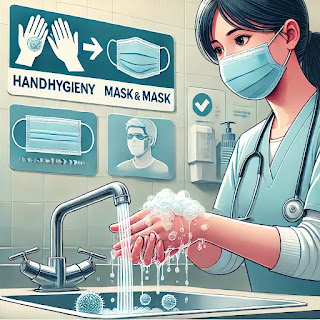When it comes to respiratory viruses, most people are
familiar with the flu, RSV (respiratory syncytial virus), and, of course,
COVID-19. But there’s another virus quietly making its rounds, affecting
thousands of people each year—Human Metapneumovirus, or HMPV. Despite its low
profile, HMPV is a significant cause of respiratory infections, especially in
children, older adults, and those with weakened immune systems. In this blog
post, we’ll dive into what HMPV is, its symptoms, how it spreads, and what you
can do to protect yourself and your loved ones.
What Is HMPV?
Human Metapneumovirus (HMPV) is a respiratory virus that was
first identified in 2001 by Dutch scientists. It belongs to the same family as
RSV and shares many similarities in terms of symptoms and transmission. HMPV is
a leading cause of upper and lower respiratory tract infections, particularly
during the winter and spring months.
While it often flies under the radar, studies suggest that
nearly everyone has been infected with HMPV by the age of 5. However, because
its symptoms mimic those of the common cold or flu, many cases go undiagnosed.
Symptoms of HMPV
HMPV can cause a range of symptoms, from mild to severe,
depending on the age and health of the individual. Common symptoms include:
- Cough
- Runny or stuffy nose
- Sore throat
- Fever
- Wheezing or difficulty breathing (in more severe cases)
In healthy adults, HMPV often feels like a bad cold.
However, for infants, older adults, and individuals with compromised immune
systems, the virus can lead to more serious complications, such as bronchitis,
pneumonia, or worsening of existing respiratory conditions like asthma.
How Does HMPV Spread?
Like other respiratory viruses, HMPV spreads through:
- Respiratory droplets: When an infected person coughs or sneezes, tiny droplets containing the virus can land in the mouths or noses of people nearby.
- Direct contact: Touching a surface contaminated with the virus and then touching your face can also lead to infection.
- Close personal contact: Hugging, shaking hands, or sharing utensils with an infected person increases the risk of transmission.
HMPV is highly contagious, and outbreaks are common in
settings like schools, daycare centers, and nursing homes.
Who Is Most at Risk?
While anyone can contract HMPV, certain groups are more
vulnerable to severe illness:
- Infants and young children: Their immune systems are still developing, making them more susceptible to respiratory infections.
- Older adults: Aging weakens the immune system, increasing the risk of complications.
- People with chronic conditions: Those with asthma, COPD, or weakened immune systems are at higher risk for severe symptoms.
- Healthcare workers: Frequent exposure to sick individuals puts them at greater risk of contracting and spreading the virus.
Diagnosis and Treatment
Diagnosing HMPV can be tricky because its symptoms overlap
with those of other respiratory viruses. Doctors typically use a combination of
physical exams, patient history, and laboratory tests (such as nasal swabs) to
confirm an HMPV infection.
Unfortunately, there is no specific antiviral treatment for
HMPV. Most cases are managed with supportive care, including:
- Rest
- Hydration
- Over-the-counter medications to relieve fever and congestion
- In severe cases: Hospitalization may be required for oxygen therapy or other interventions.
How to Protect Yourself from HMPV
Prevention is key when it comes to HMPV. Here are some
practical steps you can take to reduce your risk of infection:
- Practice good hand hygiene: Wash your hands frequently with soap and water for at least 20 seconds, especially after being in public spaces or around someone who is sick.
- Avoid close contact with sick individuals: If someone in your household is ill, try to maintain some distance and avoid sharing personal items.
- Disinfect frequently touched surfaces: Regularly clean doorknobs, light switches, and other high-touch areas.
- Wear a mask in crowded places: Masks can help reduce the spread of respiratory viruses, including HMPV.
- Boost your immune system: Eat a balanced diet, exercise regularly, and get enough sleep to keep your immune system strong.
Why Isn’t HMPV More Well-Known?
Despite its prevalence, HMPV doesn’t get as much attention
as other respiratory viruses. This is partly because it’s often mistaken for
the common cold or flu, and many cases are mild. Additionally, there’s no
vaccine or specific treatment for HMPV, which means it doesn’t make headlines
like COVID-19 or the flu.
However, researchers are increasingly studying HMPV to
better understand its impact and develop effective prevention and treatment
strategies. As awareness grows, so does the hope for improved outcomes for
those affected by this virus.
The Bottom Line
Human Metapneumovirus (HMPV) may not be a household name,
but it’s a significant cause of respiratory illness, particularly for
vulnerable populations. By understanding the symptoms, transmission, and
prevention strategies, you can take steps to protect yourself and your family.
If you or a loved one experiences severe respiratory symptoms, don’t hesitate to seek medical attention. While HMPV is often mild, it’s important to rule out more serious conditions and receive appropriate care.



Post a Comment